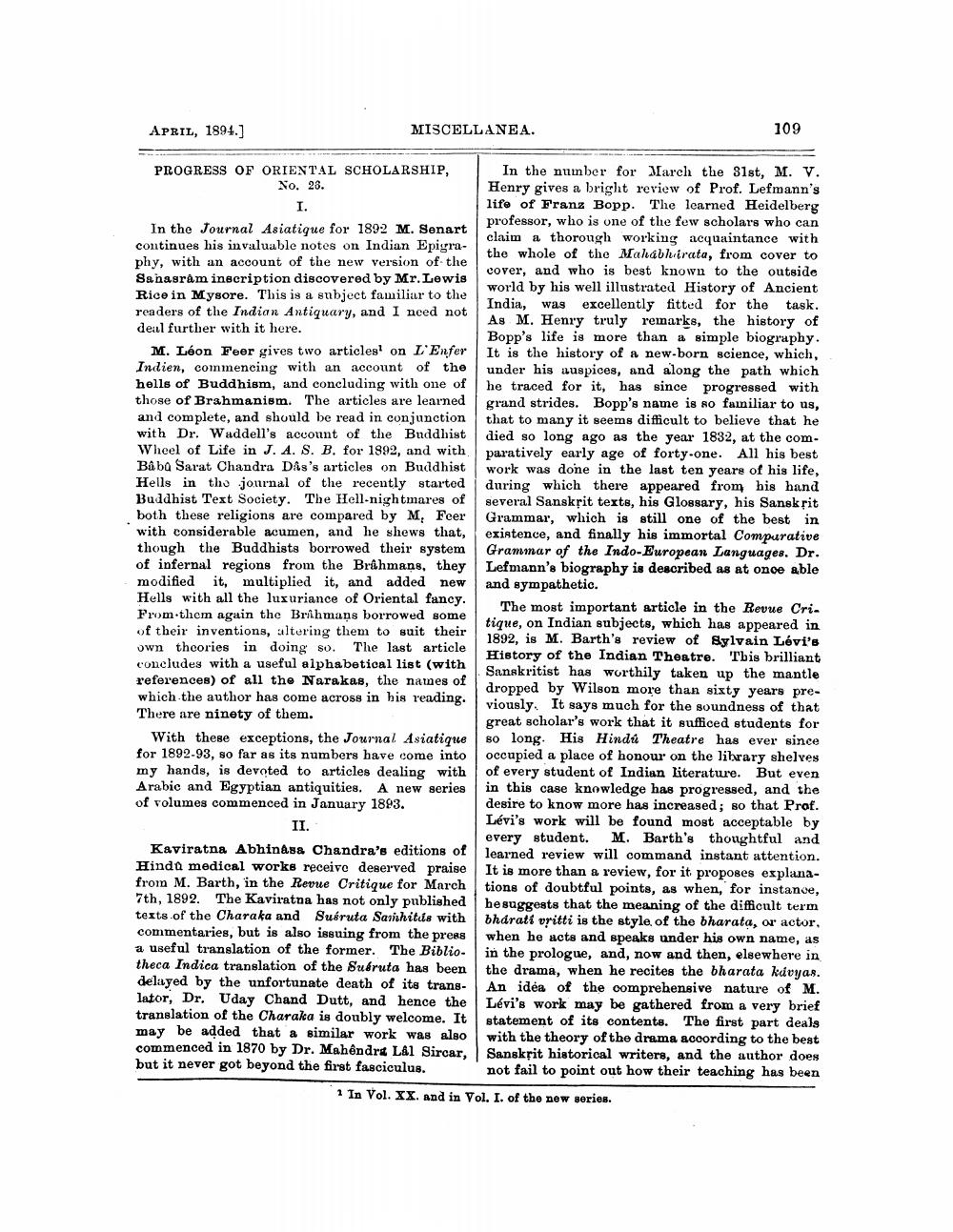________________
109
MISCELLANEA.
APRIL, 1894.]
PROGRESS OF ORIENTAL SCHOLARSHIP, In the number for March the 31st, M. V. No. 28.
Henry gives a bright review of Prof. Lefmann's life of Franz Bopp. The learned Heidelberg
professor, who is one of the few scholars who can In the Journal Asiatigue for 1892 M. Senart
| claim a thorough working acquaintance with continues his invaluable notes on Indian Epigra
the whole of the Mahabhirata, from cover to phy, with an account of the new version of the
cover, and who is best known to the outside Sa nasram inscription discovered by Mr. Lewis
world by his well illustrated History of Ancient Rice in Mysore. This is a subject familiar to the
India, was excellently fitted for the task. readers of the Indian Antiquary, and I need not
As M. Henry truly remarks, the history of deal further with it here.
Bopp's life is more than a simple biography. M. Léon Feer gives two articles on L'Enfer It is the history of a new-born science, which, Indien, commencing with an account of the under his auspices, and along the path which hells of Buddhism, and concluding with one of
he traced for it, has since progressed with those of Brahmanism. The articles are learned grand strides. Bopp's name is Ro familiar to us, and complete, and should be read in conjunction that to many it seems difficult to believe that he with Dr. Waddell's account of the Buddhist died so long ago as the year 1832, at the comWheel of Life in J. A. S. B. for 1892, and with paratively early age of forty-one. All his best Baba Sarat Chandra Dås's articles on Buddhist work was done in the last ten years of his life, Hells in the journal of the recently started during which there appeared from his hand Buddhist Text Society. The Hell-nightmares of several Sansksit texts, his Glossary, his Sanskrit both these religions are compared by M, Foer Grammar, which is still one of the best in with considerable acumen, and he shews that, existence, and finally his immortal Compurative though the Buddhists borrowed their system Grammar of the Indo-European Languages. Dr. of infernal regions from the Brahmans, they Lefmann's biography is described as at once able modified it, multiplied it, and added new
and sympathetic. Hells with all the luxuriance of Oriental fancy.
The most important article in the Revue Cri. From them again the Brihmans borrowed some
tique, on Indian subjects, which has appeared in of their inventions, altering them to suit their
1892, is M. Barth's review of Sylvain Levi's own theories in doing so. The last article
History of the Indian Theatre. Tbis brilliant concludes with a useful alphabetical list (with
Sanskritist has worthily taken up the mantle references) of all the Narakas, the names of
dropped by Wilson more than sixty years prewhich the author has come across in his reading.
viously. It says much for the soundness of that There are ninety of them.
great scholar's work that it sufficed students for With these exceptions, the Journal Asiatique 80 long. His Hindi Theatre has ever since for 1892-93, so far as its numbers have come into occupied a place of honour on the library shelves my hands, is devoted to articles dealing with of every student of Indian literature. But even Arabic and Egyptian antiquities. A new series in this case knowledge has progressed, and the of volumes commenced in January 1893.
desire to know more has increased; so that Prof.
Lévi's work will be found most acceptable by II.
every student. M. Barth's thoughtful and Kaviratna Abhinass Chandra's editions of learned review will command instant attention. Hinda medical works receive deserved praise It is more than a review, for it proposes explanafrom M. Barth, in the Revue Critique for March tions of doubtful points, as when, for instance, 7th. 1892. The Kaviratna has not only published he suggests that the meaning of the difficult term texts of the Charaka and Susruta Sarnhitis with bhdrati vritti is the style of the bharata, or actor, commentaries, but is also issuing from the press when he acts and speaks under his own name, as
eful translation of the former. The Biblio- in the prologue, and, now and then, elsewhere in theca Indica translation of the Suéruta has been the drama, when he recites the bharata kávyas. delayed by the unfortunate death of its trans- An idea of the comprehensive nature of M. lator, Dr. Uday Chand Dutt, and hence the Lévi's work may be gathered from a very brief translation of the Charaka is doubly welcome. It statement of its contents. The first part deals may be added that a similar work was also with the theory of the drama according to the best commenced in 1870 by Dr. Mahendre Lal Sircar, Sanskrit historical writers, and the author does but it never got beyond the first fasciculus. not fail to point out how their teaching has been
1 In Vol. XX. and in Yol. I. of the new series.




